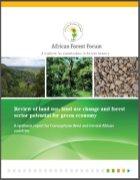This study aimed to assess the green economy potential in the forest sector. It identified and analysed key elements within the forest sector that contribute to green economy, as well as the various parameters that characterise land use and land use changes in three French-speaking African countries (Benin, Gabon, Niger). Data were collected through desk study and field visits in the selected countries.
In each of the selected countries, the forest sector is already playing a leading role in green economy. Indeed, forest trees absorb CO2 emissions, provide resources to local populations, and protect communities from increasingly erratic weather. To make these contributions sustainable, many actions have been undertaken at country level to maintain or increase forest cover. Many afforestation programmes are being implemented and forest management plans have been improved in ways that involve local communities more and increase the benefits they derive from forest resources.
The main causes of deforestation in these countries include agriculture expansion, wood extraction, grazing, hunting and urbanization. None of the countries involved in this study were REDD+ countries at the time of the study; however, the study showed that only Benin expressed interest in being involved in this process while Gabon is opposed to this mechanism. Niger is not opposed to the mechanism and as revealed through this study initiatives are currently underway for the country’s involvement in the near future.
All of the three countries have signed many international conventions, action plans and developed very good legislations in the forest sector but their implementation remains limited. To increase forest potential to contribute to green economy there is the need to:
• develop more afforestation programmes with the view to increasing the countries forest cover, and especially so in Benin and Niger;
• consider REDD+, as a strong catalyst for the green economy;
• implement the countries’ forest policies and legal frameworks for better local communities’ integration into forest management strategies that can improve their improved well-being;
• enhance efforts on conservation and sustainable use of biological diversity, especially with regard to NTFPs;
• promote payments for environmental and ecosystem services;
• strengthen NTFPs value chains to increase their contribution to people’s well-being; and
• strengthen the capacity of national managerial staff on the concept of green economy and its facets through social and environmental policymaking and how they could integrate the same into national priorities.

